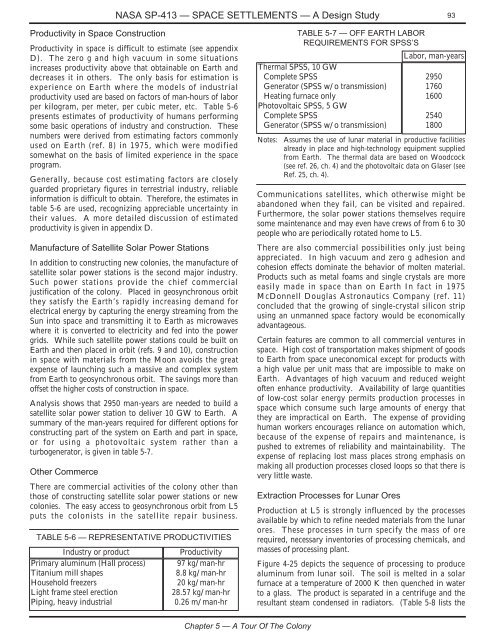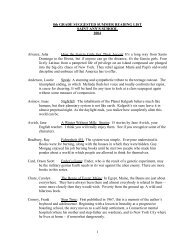NASA SP-413 Space Settlements - Saint Ann's School
NASA SP-413 Space Settlements - Saint Ann's School
NASA SP-413 Space Settlements - Saint Ann's School
You also want an ePaper? Increase the reach of your titles
YUMPU automatically turns print PDFs into web optimized ePapers that Google loves.
<strong>NASA</strong> <strong>SP</strong>-<strong>413</strong> — <strong>SP</strong>ACE SETTLEMENTS — A Design Study<br />
93<br />
Productivity in <strong>Space</strong> Construction<br />
Productivity in space is difficult to estimate (see appendix<br />
D). The zero g and high vacuum in some situations<br />
increases productivity above that obtainable on Earth and<br />
decreases it in others. The only basis for estimation is<br />
experience on Earth where the models of industrial<br />
productivity used are based on factors of man-hours of labor<br />
per kilogram, per meter, per cubic meter, etc. Table 5-6<br />
presents estimates of productivity of humans performing<br />
some basic operations of industry and construction. These<br />
numbers were derived from estimating factors commonly<br />
used on Earth (ref. 8) in 1975, which were modified<br />
somewhat on the basis of limited experience in the space<br />
program.<br />
Generally, because cost estimating factors are closely<br />
guarded proprietary figures in terrestrial industry, reliable<br />
information is difficult to obtain. Therefore, the estimates in<br />
table 5-6 are used, recognizing appreciable uncertainty in<br />
their values. A more detailed discussion of estimated<br />
productivity is given in appendix D.<br />
Manufacture of Satellite Solar Power Stations<br />
In addition to constructing new colonies, the manufacture of<br />
satellite solar power stations is the second major industry.<br />
Such power stations provide the chief commercial<br />
justification of the colony. Placed in geosynchronous orbit<br />
they satisfy the Earth’s rapidly increasing demand for<br />
electrical energy by capturing the energy streaming from the<br />
Sun into space and transmitting it to Earth as microwaves<br />
where it is converted to electricity and fed into the power<br />
grids. While such satellite power stations could be built on<br />
Earth and then placed in orbit (refs. 9 and 10), construction<br />
in space with materials from the Moon avoids the great<br />
expense of launching such a massive and complex system<br />
from Earth to geosynchronous orbit. The savings more than<br />
offset the higher costs of construction in space.<br />
Analysis shows that 2950 man-years are needed to build a<br />
satellite solar power station to deliver 10 GW to Earth. A<br />
summary of the man-years required for different options for<br />
constructing part of the system on Earth and part in space,<br />
or for using a photovoltaic system rather than a<br />
turbogenerator, is given in table 5-7.<br />
Other Commerce<br />
There are commercial activities of the colony other than<br />
those of constructing satellite solar power stations or new<br />
colonies. The easy access to geosynchronous orbit from L5<br />
puts the colonists in the satellite repair business.<br />
TABLE 5-6 — REPRESENTATIVE PRODUCTIVITIES<br />
Industry or product<br />
Primary aluminum (Hall process)<br />
Titanium mill shapes<br />
Household freezers<br />
Light frame steel erection<br />
Piping, heavy industrial<br />
Productivity<br />
97 kg/man-hr<br />
8.8 kg/man-hr<br />
20 kg/man-hr<br />
28.57 kg/man-hr<br />
0.26 m/man-hr<br />
Thermal <strong>SP</strong>SS, 10 GW<br />
Complete <strong>SP</strong>SS<br />
Generator (<strong>SP</strong>SS w/o transmission)<br />
Heating furnace only<br />
Photovoltaic <strong>SP</strong>SS, 5 GW<br />
Complete <strong>SP</strong>SS<br />
Generator (<strong>SP</strong>SS w/o transmission)<br />
Notes:<br />
TABLE 5-7 — OFF EARTH LABOR<br />
REQUIREMENTS FOR <strong>SP</strong>SS’S<br />
Labor, man-years<br />
Communications satellites, which otherwise might be<br />
abandoned when they fail, can be visited and repaired.<br />
Furthermore, the solar power stations themselves require<br />
some maintenance and may even have crews of from 6 to 30<br />
people who are periodically rotated home to L5.<br />
There are also commercial possibilities only just being<br />
appreciated. In high vacuum and zero g adhesion and<br />
cohesion effects dominate the behavior of molten material.<br />
Products such as metal foams and single crystals are more<br />
easily made in space than on Earth In fact in 1975<br />
McDonnell Douglas Astronautics Company (ref. 11)<br />
concluded that the growing of single-crystal silicon strip<br />
using an unmanned space factory would be economically<br />
advantageous.<br />
Certain features are common to all commercial ventures in<br />
space. High cost of transportation makes shipment of goods<br />
to Earth from space uneconomical except for products with<br />
a high value per unit mass that are impossible to make on<br />
Earth. Advantages of high vacuum and reduced weight<br />
often enhance productivity. Availability of large quantities<br />
of low-cost solar energy permits production processes in<br />
space which consume such large amounts of energy that<br />
they are impractical on Earth. The expense of providing<br />
human workers encourages reliance on automation which,<br />
because of the expense of repairs and maintenance, is<br />
pushed to extremes of reliability and maintainability. The<br />
expense of replacing lost mass places strong emphasis on<br />
making all production processes closed loops so that there is<br />
very little waste.<br />
Extraction Processes for Lunar Ores<br />
2950<br />
1760<br />
1600<br />
2540<br />
1800<br />
Assumes the use of lunar material in productive facilities<br />
already in place and high-technology equipment supplied<br />
from Earth. The thermal data are based on Woodcock<br />
(see ref. 26, ch. 4) and the photovoltaic data on Glaser (see<br />
Ref. 25, ch. 4).<br />
Production at L5 is strongly influenced by the processes<br />
available by which to refine needed materials from the lunar<br />
ores. These processes in turn specify the mass of ore<br />
required, necessary inventories of processing chemicals, and<br />
masses of processing plant.<br />
Figure 4-25 depicts the sequence of processing to produce<br />
aluminum from lunar soil. The soil is melted in a solar<br />
furnace at a temperature of 2000 K then quenched in water<br />
to a glass. The product is separated in a centrifuge and the<br />
resultant steam condensed in radiators. (Table 5-8 lists the<br />
Chapter 5 — A Tour Of The Colony
















